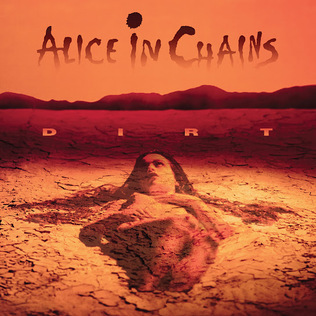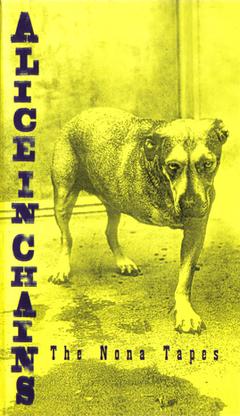
Alice in Chains is an American rock band formed in Seattle, Washington, in 1987. Since 2006, the band's lineup has comprised vocalist/guitarists Jerry Cantrell and William DuVall, bassist Mike Inez and drummer Sean Kinney. Vocalist Layne Staley and bassist Mike Starr are former members of the band. The band took its name from Staley's previous group, Alice N' Chains. Often associated with grunge music, Alice in Chains' sound and style is deeply rooted in heavy metal music. The band is known for its distinctive vocal style, which often included the harmonized vocals between Staley and Cantrell, making Alice in Chains a two-vocal band.

Dirt is the second studio album by American rock band Alice in Chains. It was released on September 29, 1992, by Columbia Records. Peaking at No. 6 on the Billboard 200 chart, the album received critical acclaim. It has since been certified quintuple platinum by the Recording Industry Association of America (RIAA), making Dirt the band's highest selling album to date. It was the band's last album recorded with all four original members, as bassist Mike Starr was fired in January 1993 during the tour to support the album. The album spawned five singles: "Would?", "Them Bones", "Angry Chair", "Rooster", and "Down in a Hole", all with accompanying music videos. Dirt was nominated for a Grammy Award for Best Hard Rock Performance. The music video for "Would?" was nominated for an MTV Video Music Award for Best Video from a Film, as the song was featured on the soundtrack to Cameron Crowe's 1992 film Singles.

Layne Thomas Staley was an American singer and songwriter who was the original lead vocalist of Alice in Chains, which rose to international fame in the early 1990s as part of Seattle's grunge movement. He was known for his distinctive vocal style as well as his harmonizing with bandmate Jerry Cantrell. Prior to his success with Alice in Chains, Staley was also a member of the glam metal bands Sleze and Alice N' Chains. He was also a part of the supergroups Mad Season and Class of '99.

Sap is the second studio EP by the American rock band Alice in Chains, released on February 4, 1992, through Columbia Records. Sap is mostly acoustic and marks the first time that guitarist Jerry Cantrell sings lead vocals in an Alice in Chains release, with the song "Brother". The EP was produced by Alice in Chains and Rick Parashar and features guest vocals by Ann Wilson of the band Heart, Chris Cornell of Soundgarden and Mark Arm of Mudhoney. The track "Got Me Wrong" became a hit two years later after being featured on the soundtrack to the 1994 film Clerks. On January 14, 1994, Sap was certified gold by the RIAA for the sale of more than 500,000 copies.

Jerry Fulton Cantrell Jr. is an American guitarist, singer, and songwriter. He is best known as the founder, lead guitarist, co-lead vocalist, and main songwriter of the rock band Alice in Chains. The band rose to international fame in the early 1990s during Seattle's grunge movement and is known for its distinctive vocal style and the harmonized vocals between Cantrell and Layne Staley. Cantrell started to sing lead vocals on Alice in Chains' 1992 EP Sap. After Staley's death in 2002, Cantrell took the role of Alice in Chains' lead singer on most of the songs from the band's post-Staley albums, Black Gives Way to Blue (2009), The Devil Put Dinosaurs Here (2013), and Rainier Fog (2018), with DuVall harmonizing with him in the new songs and singing Staley's vocals in the old songs in live concerts.

Jar of Flies is the third studio EP by American rock band Alice in Chains. It was released on January 25, 1994, by Columbia Records. The band's second acoustic EP, after 1992's Sap, it was the first EP in music history to debut at No. 1 on the Billboard 200 chart, with the first week sales exceeding 141,000 copies in the United States. The self-produced record was written and recorded over the course of just one week at the London Bridge Studio in Seattle. The tracks "No Excuses", "I Stay Away" and "Don't Follow" were released as singles to promote the EP. Jar of Flies was nominated for two Grammy Awards in 1995: Best Recording Package and Best Hard Rock Performance for "I Stay Away".

Alice in Chains is the third studio album by American rock band Alice in Chains. It was released on November 7, 1995, by Columbia Records, and was the follow-up to the highly successful Dirt (1992). This is the band's first full-length studio album to feature bassist Mike Inez and their last studio album to feature original lead vocalist Layne Staley before his death in 2002. It is also their final studio album to be released through Columbia. As with their previous releases, the album's songs focus on heavy emotional content and subject matter such as drug addiction, depression, religion, broken relationships, and the internal tensions within the band fueled by Staley's substance abuse. The album's music relies less on metallic riffs and more on melody and texturally varied arrangements, integrating some of the more delicate acoustic moods of their EPs.

"Man in the Box" is a song by the American rock band Alice in Chains. It was released as a single in January 1991 after being featured on the group's debut studio album, Facelift (1990). It peaked at No. 18 on Billboard's Mainstream Rock chart and was nominated for a Grammy Award for Best Hard Rock Performance in 1992. The song was included on the compilation albums Nothing Safe: Best of the Box (1999), Music Bank (1999), Greatest Hits (2001), and The Essential Alice in Chains (2006). "Man in the Box" was the second most-played song of the decade on mainstream rock radio between 2010 and 2019.

We Die Young is a song and single EP by the American rock band Alice in Chains, engineered and co-produced by Dave Jerden. It was released in July 1990 and is their first studio EP. This was a promo-only EP released on vinyl and cassette, and is thus a sought-after collector's item amongst Alice in Chains fans.

Sean Howard Kinney is an American musician, best known as the drummer and co-founder of the rock band Alice in Chains. Kinney also founded the short-lived supergroup Spys4Darwin, and has collaborated with other artists such as Johnny Cash and Metallica. He played drums for his Alice in Chains bandmate, Jerry Cantrell's first solo album, Boggy Depot (1998). Since 2009, Kinney has been co-owner of The Crocodile club in Seattle. He was a guest drummer on NBC's Late Night with Seth Meyers in September 2018. Kinney has earned nine Grammy Award nominations as a member of Alice in Chains.

"Them Bones" is a song by American rock band Alice in Chains. It was released as the second single from their second studio album, Dirt (1992). "Them Bones" peaked at No. 24 on Billboard's Mainstream Rock chart and at No. 30 on the Modern Rock Tracks chart. The song was included on the band's compilation albums Nothing Safe: Best of the Box (1999), Greatest Hits (2001) and The Essential Alice in Chains (2006). It was also included on the box set Music Bank (1999). A live performance of the song was included on their second live album, Live (2000).

Michael Christopher Starr was an American musician best known as the original bassist for the rock band Alice in Chains, with which he played from the band's formation in 1987 until January 1993. He was also a member of Sato, Gypsy Rose, Sun Red Sun and Days of the New.

"Would?" is a song by Alice in Chains, written by guitarist and vocalist Jerry Cantrell as a tribute to his friend Andrew Wood, lead vocalist of Mother Love Bone, who died in 1990. Cantrell sings the verses of the song, while Layne Staley sings the chorus.

"Grind" is a song by American rock band Alice in Chains. It is the opening track and the lead single from their third studio album, Alice in Chains (1995). The song was written by Jerry Cantrell, who also sings lead vocals with Layne Staley harmonizing with him. "Grind" spent 16 weeks on the Billboard Album Rock Tracks chart, peaking at number seven. The song was included on the compilation albums Nothing Safe: Best of the Box (1999), Music Bank (1999), Greatest Hits (2001), and The Essential Alice in Chains (2006). It was nominated for the Grammy Award for Best Hard Rock Performance in 1996.

"Sea of Sorrow" is a song by the American rock band Alice in Chains, featured on their debut full-length album Facelift (1990). The song was included on the compilation album The Essential Alice in Chains (2006). A demo version of the song was included on the box set Music Bank (1999).

"Get Born Again" is a song by the American rock band Alice in Chains and, along with "Died", one of the last two songs recorded with vocalist Layne Staley before his death in 2002. The song was released as the lead single from the compilation Nothing Safe: Best of the Box (1999) on June 1, 1999. It peaked at No. 4 on the Billboard Mainstream Rock Tracks chart, and at No. 12 on the Modern Rock Tracks chart. "Get Born Again" was nominated for the Grammy Award for Best Hard Rock Performance in 2000. The song was also included on the compilation albums Music Bank (1999) and The Essential Alice in Chains (2006).

The Nona Tapes is a 1995 mockumentary by the American rock band Alice in Chains directed by Rocky Schenck to promote the band's self-titled album. Released on VHS on December 12, 1995, it features journalist Nona Weisbaum interviewing the band in Seattle and also includes the music video for the album's lead single, "Grind", and outtake footage overdubbed with the second single, "Heaven Beside You". The Nona Tapes became a cult hit despite Columbia Records not liking it at first. It peaked at No. 23 on Billboard's Top Video Sales and at No. 25 on the Top Music Videos chart. Because it is no longer for sale, original copies of the VHS are considered a rarity. However, in 2006, Best Buy offered a DVD version for free for a limited time with purchases of the compilation The Essential Alice in Chains. On June 19, 2017, Alice in Chains' official Vevo channel uploaded the video on YouTube.
"Don't Follow" is a song by American rock band Alice in Chains. It is the third single from the band's 1994 EP Jar of Flies. The song was written by guitarist and vocalist Jerry Cantrell, who sings lead vocals in the first part of the song, followed by Layne Staley in the second part. The single spent seven weeks on Billboard's Mainstream Rock Tracks chart and peaked at No. 25.

Alice N' Chains was an American glam metal band from Seattle, Washington, formed in 1986 by former members of Sleze. Toward the end of their run as Sleze, discussions arose about changing their name to Alice in Chains. However, due to concerns over the reference to female bondage, the group ultimately chose to spell it as Alice N' Chains. They performed under this moniker over about a 12-month period and recorded two demos before breaking up on friendly terms in 1987. One of its members, Layne Staley, ultimately took the name that he and his former bandmates had initially flirted with when he joined a different group a few months later that became known as Alice in Chains.
"Sunshine" is a song by the American rock band Alice in Chains and the eighth track on their debut album, Facelift (1990). The song was written by guitarist and vocalist Jerry Cantrell as a tribute to his mother Gloria, who died in 1987.

















